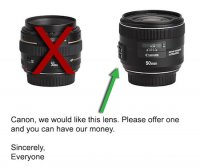Why do so many people assume this is a do or die situation for Canon. It's entirely possible to have an EF mount now and wait to introduce a new mount later, one that will work with curved sensors or Medium Format sensor. Also these Rube Goldberg shifting sensor mechanisms don't sound so attractive especially since Canon are known for reliability, quality and performance. Keep it simple Canon, EF mount now sit back and plan something truly revolutionary for the next mount.
There's a perception that the near-term is a critical inflection point where Canon needs to get in and stop some ascendant Sony market share phenomenon in the making. As Neuro pointed out, Sony is not winning unit share
yet -- they continue to stumble on basics, support, accessories, etc. But few would doubt that their products (with their A7 III generation) are not making strides towards a point where Sony will finally start flipping a lot of professionals and enthusiasts into their ranks.
A poorly spec'd FF mirrorless that either leaves out a critical feature (4K, IBIS, every day more calls for Eye AF, etc.), leaves a big part of the market behind (i.e. full EF vs. thin mount), etc. could be the tipping point that pushes people to Sony -- warts and all. There comes a point that the spec per dollar value proposition is so much better (coupled with finally getting some lenses) and Sony becomes that 6 out of 10 option that is consistently trending upwards enough that folks stop waiting for Canon to give them the camera they want.
Many folks feel that time is now.
I am not one of them, but I also think it's not Canon's MO to stay on the sidelines this long. I don't personally believe an off-target FF mirrorless will be Canon's undoing at all, but a poorly thought through platform could be an anchor around their necks that they might stick with rather than fix (Nikon 1, I'm looking at you).
In short, Canon's greatest threat may not be Sony -- it might be Canon itself. They could end up rocking the boat with a bad major decision on this platform. Don't believe me? When they launch this thing, see how long/often Canon points out that EF is going to work and work perfectly with this new system. They will be reassuring as many people as they are prospectively selling this new system to. They have (in many folks' minds) more to lose than to gain.
But you are right, Canon is absolutely big enough to get this wrong, course correct and get back on track.
- A

